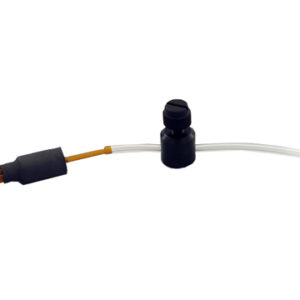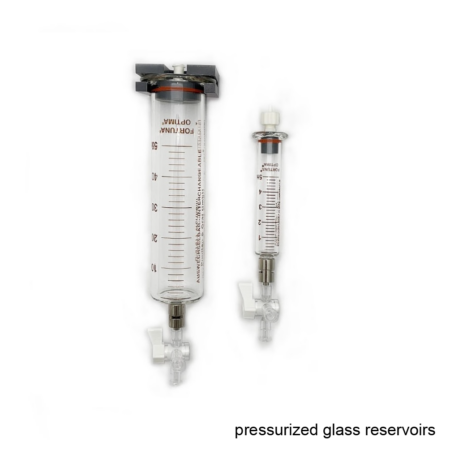Description
ALA Scientific’s 8 channel gravity flow perfusion systems fulfill the basic requirements of the student lab and can also be optimized to fit the most demanding applications of patch clamp recording and/or imaging. All VCPlus gravity systems provide electronic control of solution exchange. This improves reproducibility over manual methods. These systems are designed to minimize electronic noise so sensitive electrophysiological recordings can be performed.
Key features of the VCPlus-8 gravity systems include:
Choice of low-maintenance pinch valves or fast response isolation valves
• Customizable reservoir sizes and materials
• Valve control through DAQ, VCPlus software, or controller
• Optional spill sensor with automatic shutoff to protect microscope optics
• MilliManifold™ and MicroManifold® outlet options for low volume and rapid applications
• TTL timestamp to indicate valve opening
• Spike and hold circuit for each valve for rapid valve opening and cool valve operation
VCPlus Systems have the option of integrating either pinch or isolation valves. Three-way pinch valves have response times of 15-20ms and are easy to clean because solution runs through the valve in removable tubing. Isolation valves have response times of 2-3ms and are made for high speed applications.
Unlike other competitive perfusion systems, all VCPlus systems include Windows compatible command software. This software allows users to set protocols for opening and closing of specific channels for preset amounts of time. Protocols can be initiated by starting within software or by external trigger from data acquisition systems. Individual valves of the VCPlus systems can also be controlled via analog or TTL input.
Last Updated on January 30, 2025
Details
Perfusion is critical in most biological applications, both for maintaining the viability of preparations and establishing experimental conditions. Electronic control of solution exchange improves fluid delivery and enhances reproducibility over manual methods. With the VCPlus systems, you can configure systems for the basic requirements of the student lab or you can optimize them for the most demanding applications of patch-clamp recording and/or imaging.
VCPlus Gravity Systems use gravity to drive the solution flow. Gravity driven systems are ideal for use with larger diameter tubing and can be used to perfuse bath preparations to maintain viability and establish experimental conditions. Gravity systems include valve manifold with isolation or pinch valves, 60 ml reservoirs, VCPlus controller, power supply, luer valves, magnetic stand, USB-C cable, and software. Options include different perfusion outlet manifolds (MLF or MMF), spill sensor, flow control valve, and BOB-8 BNC interface box for TTL control via DAQ’s.
VCPlus Gravity System Highlights
- 4 & 8 channel versions
- Easy and fast setup
- Optional MilliManifoldTM or MiniManifoldTM outlets & FCV-1 flow control valve are available
- Electronics compatible with electrophysiology
- Low maintenance pinch valves or fast response isolation valves
- Comes complete with all tubing
Each VCPlus-8xG Series system includes the following:
- Magnetic stand with 2 x 18” poles
- Valve manifold with isolation or pinch valves
- Reservoir bracket with 60mL syringe reservoirs
- VCPlus electronic valve controller with a USB-C cable and control software
- DB9-CABLE controller to valve manifold cable
- Manual 3-way stop cock Luer valves and tubing
- **MMF-8 MiniManifold™ or MLF-8 MilliManifold™ 8 channel perfusion outlet manifolds need to be ordered separately**
- Spill sensor and Flow Control Valve are options and need to be ordered separately.
- Each VCPlus-8xG Series system features a choice of valves:
- Pinch valves : The 3-way normally open and normally closed
 pinch valves require minimal maintenance in long-term perfusion experiments and have response times of 15-20ms.
pinch valves require minimal maintenance in long-term perfusion experiments and have response times of 15-20ms.
- Isolation valves: These 2-way normally
 closed isolation valves are optimized for high-speed solution exchange. These valves are completely isolated when closed and have response times of 2 to 3ms.
closed isolation valves are optimized for high-speed solution exchange. These valves are completely isolated when closed and have response times of 2 to 3ms.
Additional options include:
- Spill sensor: used to detect spills around the microscope to prevent damage to expensive optics
- Flow Control Valve, FCV-1: manual pinch valve with thumb screw to adjust output flow rates from the output of the MMF-8 or MLF-8
- 5ml or 10ml syringe reservoirs
- Breakout Box: BOB-8 for TTL trigger inputs
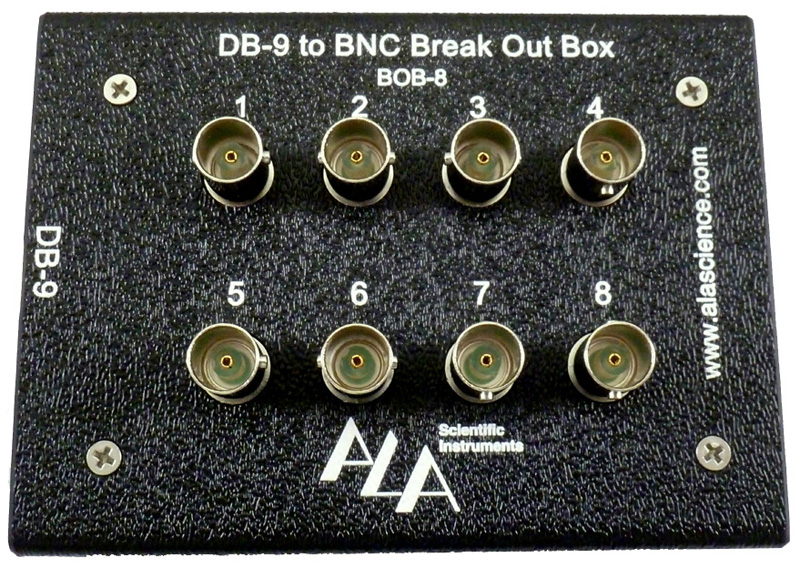
Last Updated on January 30, 2025
Specifications
Valve Controller:
- Dimensions/Weight: 8″/20.32cm x 6″/15.24cm x 2.5″/6.35cm / 1.5lbs/0.68kg
- Power: 15VDC/3.15A
- Computer Control Input: Analog input 0.5V/valve TTL high 1 bit/valve; USB 2.0
- Computer Output Monitoring: Analog output 0.5V/valve; Sync TTL high 20ms;
- Manual Control: Membrane switch 1/valve; mom on/off or toggle on/off, latching on/off
Valve Manifolds:
- Pinch Valves: 12VDC/0.25A ea. 3 way Pinch Valve
- Pinch Valve Opening Speed: 15 to 20ms
- Pinch Valve ID Tubing: 0.040″/1mm
- Isolation Valves: 12VDC/0.25A ea.
- Isolation Valve Opening Speed: 2-3ms
- Reservoirs: 60mL luer lock syringes
|
Pinch Valve
|
Isolation valve
|
|
3 way
|
NO/NC port
|
NC port
|
|
Response time
|
15 to 20ms
|
2 to 3ms
|
|
Wetted area
|
silicone tubing
|
PTFE
|
|
Voltage
|
12V
|
12V
|
|
Power
|
4.2W
|
1W
|
Gravity flow rate specifications assuming 60mL reservoirs are full without the manual pinch flow valve attached:
|
Height (cm)
|
with MLF (mL/min)
|
with MMF (mLmin)
|
|
90
|
11
|
37
|
|
80
|
10
|
31
|
|
70
|
9
|
29
|
|
60
|
8
|
25
|
|
50
|
7
|
22
|
Last Updated on January 30, 2025
Accessories
Last Updated on January 30, 2025
References
Reduced surface pH and upregulated AE2 anion exchange in SLC26A3-deleted polarized intestinal epithelial cells
Mahdi Amiri, Min Jiang, Azam Salari, Renjie Xiu, Seth L. Alper, and Ursula E. Seidler
American Journal of Physiology-Cell Physiology 2024 326:3, C829-C842
Sugar binding of sodium-glucose cotransporters analyzed by voltage-clamp fluorometry
Erika Watabe, Akira Kawanabe, Kazuyo Kamitori, Satoko Ichihara, Yuichiro Fujiwara
Journal of Biological Chemistry, 2024, 107215,
https://doi.org/10.1016/j.jbc.2024.107215
Last Updated on January 30, 2025
Ordering
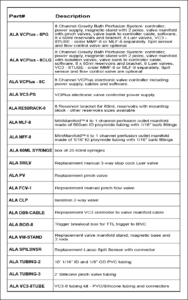
Last Updated on January 30, 2025
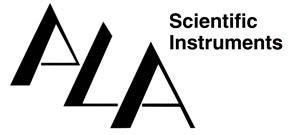



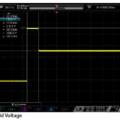
 pinch valves require minimal maintenance in long-term perfusion experiments and have response times of 15-20ms.
pinch valves require minimal maintenance in long-term perfusion experiments and have response times of 15-20ms. closed isolation valves are optimized for high-speed solution exchange. These valves are completely isolated when closed and have response times of 2 to 3ms.
closed isolation valves are optimized for high-speed solution exchange. These valves are completely isolated when closed and have response times of 2 to 3ms.



